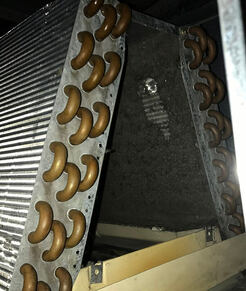 The A-coil (or evaporator coil) gets its name from its triangular shape and is a critical component of your HVAC system. It is usually located above the furnace. All the air that circulates through your system passes through the A-coil before it exits the supply vents into the desired rooms, whether your system is heating or cooling. For this reason, it is highly susceptible to buildup of dust, dirt, and contaminants. Keeping the A-coil clean of buildup is one of the most important things you can do for your HVAC system. When it is dirty or clogged, air flow is greatly compromised, causing your system to work much harder to achieve the desired temperature. What are the signs of a clogged A-coil? Of course the surest sign of a clogged coil is its visual appearance, in cases where it is accessible and not encased. (The one pictured above is a casualty of "filter bypass," with all manner of debris, including dog hair, bypassing the air filter and adhering directly to the coil.) Even the thinnest layer of grime covering its fins will significantly decrease air flow. One of the first indications a homeowner will usually have of a dirty A-coil is diminished air flow from the air vents (though this could also be caused by a damper control issue). An increase in monthly heating/cooling costs often accompanies a dirty A-coil as well, as the system must work harder and use more energy to reach the target temperature. What causes a clogged A-coil? The A-coil will naturally dirty over time, since it is consistently exposed to the air being circulated by the blower. There are, however, several key factors that will contribute to its becoming dirtier than usual, or becoming dirty more quickly than usual, and most of these are filter-related. A too-cheap air filter will often allow particles too large to pass through, resulting in more debris becoming clogged between the fins of the coil. An incorrectly sized or ill-fitting filter can allow for filter bypass, when debris is able to sneak around the filter and directly into the components of your furnace, particularly the A-coil. Of course, many a technician has opened up a furnace to find no filter at all, which is obviously extremely detrimental to the furnace components, which must be clean of debris in order to effectively transfer heat and use energy efficiently. How is an A-coil cleaned? A-coils are situated on top of the furnace and are often "hidden" behind a panel and may or may not be reasonably accessible. Before cleaning, an access point is created directly above the coil so the technician can look from above to see where he can safely cut to access the side of the coil without puncturing any of the copper lines. Once access is created there, the technician can cut access into the underside of the coil, where the cleaning tools will be inserted. Tools used will vary depending on the job but generally include high-pressured air wands, an air whip (such as the Viper), an industrial-strength vacuum, a three-inch round dust-brush head, and sometimes non-rinsing coil cleaner. How much does an A-coil cleaning cost? Coil cleanings vary widely in price, mostly due to issues of accessibility, but how dirty the coil is will affect the price as well. Most companies will bid A-coil cleanings rather than advertise set prices, because the nature of the job will differ greatly from one unit to another. It's well worth keeping in mind that whatever you spend to get your coil cleaned will easily be recovered in the form of increased energy efficiency, lower heating and cooling costs, and increased lifespan of your unit. Many thanks to our technician Ben S for lending his expertise to this article.
0 Comments
Your comment will be posted after it is approved.
Leave a Reply. |
SearchArchives
April 2022
|
Twin Cities Furnace Cleaning - Open 7 Days a Week 8AM to 8PM
